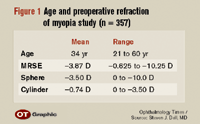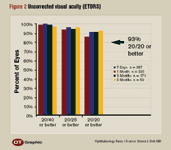Article
Wavefront-optimized LASIK comparable to wavefront-guided
Washington, DC—The initial results of a study of the MEL-80 excimer laser (Carl Zeiss Meditec) indicate that the laser has an excellent safety and efficacy profile when performing LASIK for myopia. The patients recovered their visual function rapidly, and the uncorrected visual acuity (UCVA) levels in this trial in which wavefront-guided ablation was not performed were comparable to studies in which wavefront-guided ablation was performed using other lasers.

Steven J. Dell, MD, reported the 6-month results of a prospective multicenter clinical trial at the annual meeting of the American Society of Cataract and Refractive Surgery.
Three hundred fifty-seven eyes of 181 consecutive patients were included. The study was conducted at five clinical sites nationwide. All patients underwent LASIK for myopia using the MEL-80 laser using a wavefront-optimized profile, which is an ablation program that is not wavefront driven. The MEL-80 laser uses a 0.7-mm flying spot that fires at 250 Hz with an aspheric ablation profile, explained Dr. Dell, who is in private practice in Austin, TX.
A custom ablation study is scheduled to start following completion of the wavefront-optimized profile study.
The study endpoints, according to Dr. Dell, were the UCVA, the best-corrected visual acuity (BCVA), the accuracy of the refractive outcome (intended versus achieved correction) for sphere and cylinder (by vector), refractive stability (manifest refraction), and the safety, which included loss of two or more lines of BCVA, more than 2 D of induced cylinder, adverse events, and complications.

Analysis of the MRSE predictability at 6 months indicated that there was a slight overall tendency toward overcorrection, with about 80% of eyes being within ±0.5 D of the intended correction.
"Analysis of the best spectacle-corrected visual acuity showed that at 6 months after treatment, for every eye that lost one line of vision, 5.7 eyes gained one line of vision. No eye lost two lines of vision, but 7% gained two lines," Dr. Dell stated.
No unanticipated adverse events occurred. The epithelium had to be removed from the interface in one eye, an object hit the eye of one patient, and one patient was involved in a car accident in which a head injury occurred.
"We have treated a total of 357 eyes to date," Dr. Dell concluded. "The UCVA results are similar to those achieved with wavefront-guided lasers, and the results seem to be stable at 6 months.
Newsletter
Don’t miss out—get Ophthalmology Times updates on the latest clinical advancements and expert interviews, straight to your inbox.




